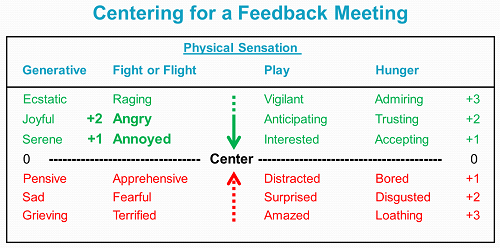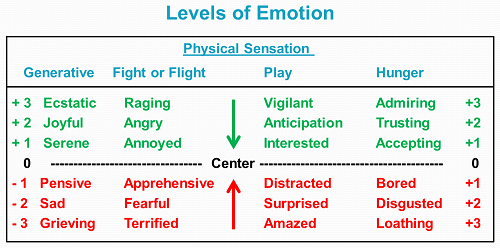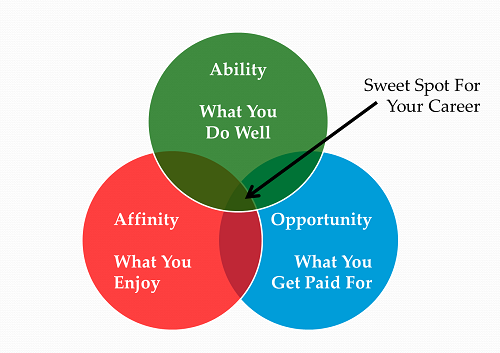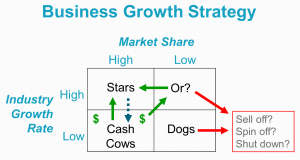When you walk in the room, who shows up for Read more →
A Declaration for the Center
Allen Slade
Before my first meeting with Bill Gates, I had every reason to be confident. Microsoft had recently recruited me for my specialized expertise. I had conducted similar meetings with other CEOs. I had a good team behind me, and I had practiced the presentation thoroughly.
The first five minutes went well. Then, Bill asked a question on a minor point. I gave a simple answer, but Bill kept drilling down on the topic. On Bill’s third or fourth question, my confidence evaporated. I was in a full scale amygdala hijack. I needed to quickly reestablish my confidence or the meeting would be a failure.
In Getting to the Center of an Emotional Storm, I suggest centering in the moment as a tool for managing your emotions as a leader. When you are in the spotlight, and your emotions are not serving you well, you can breathe, use a touchstone or make a silent declaration. While declarations can be overplayed by motivational speakers or by comedians (“I’m good enough, I’m smart enough, and doggone it, people like me.”), the right declaration can help you manage your emotions. I help my clients find declarations that work, and if declarations don’t work, we focus on other tools for managing emotions.
Declarations help direct our actions. Chalmers Brothers points out how declarations help steer things in the right direction:
For organizations and for individuals, declarations can operate like the rudder of a boat. The boat (organization or person) changes directions as a result of those with authority declaring one thing or another. Declarations are how we identify our priorities and commitments to the future and how we bring certain ways of being into existence (self-worth, well-being, dignity, among others).
For the purposes of managing your own emotions, a compelling personal declaration points you toward a different future. For someone with a fear of public speaking, an effective personal declaration might be: “I will speak with confidence.” This declaration would help moderate anxiety before and during a speech.
The “right” declaration hinges on your personal emotional life and the situation you face. Over the years, my clients have come up with a variety of compelling personal declarations: Stick the landing. Rest my hands. Be confident. Manage my emotions. Re-center. Pause for power. Speak slowly. Build credibility. Make the sale.
Four things will help make a declaration effective in managing your emotions:
Make it simple. Use short, declarative statements.
Make it positive. Don’t use “Don’t . . .” because the stickiness of the last word. “Don’t fidget” focuses the attention on fidgeting, and that will echo in your mind. Stay positive. “Be confident” or “Stick the landing” focuses attention on the new future you are declaring.
Make it powerful. Your declaration must resonate. It must make sense (impacting decision making in your prefrontal cortex) and it must also have emotional weight (impacting emotions in your amygdala).
Make it memorable. Your declaration has to be on the tip of your tongue. Stating your declaration so it is simple, positive and powerful helps. You also need to practice your declaration, starting in safe settings such as your office or with your coach.
So, how did my meeting with Bill Gates turn out? During my amygdala hijack, when my confidence was at its lowest, I centered in the moment. I took a breath, touched my signet ring and said to myself “I am one of the three best people in the world on this topic. You hired me to fix your problems.” I smiled quietly, and re-engaged with confidence.
Getting to the Center of an Emotional Storm
Allen Slade
The oddest thing about hurricanes is the calm at the center of the storm. Pelting rain and destructive winds depart. The wind is calm and the sun is shining. You know the eye won’t last, but you can take a break, step outside, do a quick check and plan how to face the rest of the storm.
Sometimes our emotions swirl like a storm. Today’s post focuses on how leaders can calm their emotions through centering. This is step four of managing emotions:
- “How am I feeling?”
- “How are my emotions serving me right now?”
- “Would different emotions (type or intensity) serve me better?”
- “How do I get there?”
For example, in a feedback meeting with a difficult employee, your fight sensation might be activated. You and your employee would be better served if you have less intense emotions. On the emotional scale below, you don’t want be so intense that you are angry (+2). However, annoyed (+1) would serve you well.
If you decide your emotions are too intense, then how can you move closer to the center? How can you create an eye in an emotional storm?
You can create emotional calm with centering. By focusing your thoughts and calming your body, you can reduce the intensity of your emotions. I use a centering exercise with my clients that takes about five minutes. It can lower your heart rate, reduce your blood pressure and (most importantly) reduce the intensity of your emotions.
You center to reduce your emotional intensity, not to totally bury your emotions. In that feedback meeting with your difficult employee, being completely serene won’t work. You care about performance and you expect to see a change. You want to experience annoyance rather than anger or rage. In general, at work we want emotional intensity of -1 to 1. Emotions at intensity level 2 could be career limiting, except at farewell parties and new product launches.
What if you are in the middle of a meeting when your emotions kick in? It is not possible to close your eyes for five minutes, so you need other tactics to center your emotions.
If someone else is talking, you can center in your chair, Modify your full-length centering exercise so it is shorter. Then, mentally check out of the meeting for 30-60 seconds. Staying seated with your eyes open, run through your routine. Here is one way to center in your chair.
If you are in the spotlight – it is your speech or you have just been called on – you can’t leave for five minutes or check out for 30 seconds. Then, your best move can be to center in the moment by taking a deep breath, touching your touchstone or making a silent declaration.
Breathing. All three exercises – centering, centering in your chair and centering in the moment – involve breathing. Taking a deep, controlled breath oxygenates your blood. This helps lower your pulse, blood pressure and adrenaline. It also establishes, at a visceral level, that you are in control. If one breath doesn’t center you enough, do two more.
Touchstone. A touchstone or totem is something you carry with you to remind you of your purpose and passion. It should have some personal meaning to you. I touch my signet ring. My ring has a custom symbol that reminds me of the important areas of my life – faith, family, friends and work. When I touch it, I remember who I am and what I am about. Your touchstone could be a piece of jewelry, a small stone, or any item that is convenient. The key is that your touchstone should be meaningful to you and should be on you whenever you might face an emotional storm.
Declaration. A centering declaration is a brief, silent statement about your purpose and identity in the form of “I am …” or “I will …” The nature of declarations will be the topic of my next post.
Managing your emotions puts you in charge. You identify your feelings and then deliberately moderate your feelings to serve you and the people around you. Even when your situation is emotionally fraught, you can manage your emotions. You can find the calm you need in the midst of an emotional storm.
The Leader’s Answer to “How Am I Feeling?”
Allen Slade
Emotions are an important part of the leadership landscape. As a leader, you need to be able to manage emotions in yourself and understand the emotions of others. Let’s look at the first step in managing emotions:
- “How am I feeling?”
- “How are my emotions serving me right now?”
- “Would different emotions (type or intensity) serve me better?”
- “How do I get there?”
As a leader, how well can you answer the first question? How well can you label your emotions?
Our ability to manage something depends, in part, on our ability to put our observations into words. If you drop me in the Sahara desert with only a water bottle, my ability to describe what I saw would be limited. “Sandy, windy, hot, dry.” I probably would not survive 24 hours without help. The best helper would be someone with the words – “Camel tracks, acacia trees, Tuareg, sirocco” – to make sense of the desert.
Leaders need a rich language of emotion. If your emotional vocabulary is a bit limited, let me suggest two steps to move beyond “sandy and hot” to “acacia and sirocco”. First, you need the words. Then, you need practice using the words.
Here is a simple model of emotions from Robert Plutchik. Emotions vary in intensity from +3 to -3. When you are centered, you are at zero for that emotion – it is not actively impacting your behavior or thinking. With four basic physical sensations, there are twenty-four unique emotions.
For most of my clients, this is a great model. If, however, you think of emotions differently, feel free to improvise. Add your own emotions, mix and match. Make sure you label both the type and intensity of your emotions. Otherwise, use whatever matches your emotional life.
For your language of emotion to take hold, you have to put it into practice. Regularly ask yourself “How am I feeling?” Answer with both type of emotion and intensity. Do this whenever you have a substantial event – a meeting, a presentation, a feedback session or a difficult conversation. Also ask yourself periodically throughout the day. It can be helpful to use some way to record your observations, like in this Managing Emotions tool.
The discipline of asking “How am I feeling?” will help you to manage your own emotions. It will also give you greater sensitivity to the emotional landscape around you. You will still find yourself lost in the desert from time to time. But at least you will have the words to make sense of the situation and plot a path to the oasis.
Emotional Intelligence is Dumb
Allen Slade
There is a problem with emotional intelligence. “Intelligence” implies an upper limit on competence. Emotional intelligence, at its worst, implies you can’t exceed your native ability.
Intelligence tests were originally designed to place children into limited academic tracks. At Riverside Elementary School, we had four tracks. At the age of 12, I was placed into the lowest track, designed for students who did not have the intellectual ability to go to college. I decided to prove the school wrong. For every question by the teacher, I was the first to raise my hand. I worked for perfection on every assignment. I helped other students master the material. Because of my efforts, I earned the nickname of “The Professor”. Something fundamentally changed in me during that year. I went to college and stayed for a while. At the age of 28, I was called professor again. But this time it was by my management students at the University of Delaware.
Tracking students based on intelligence tests may or may not be a good education strategy. Limiting your leadership based on “emotional intelligence” is just plain dumb.
What is smarter than emotional intelligence? I prefer to talk about managing emotions. Management – of organizations, projects or emotions – can be learned and mastered. Our emotional competence is virtually unlimited. As a leader, you can get better at understanding and shaping your own emotions. You can get better at understanding the emotional landscape – the patterns and peaks of the people around you. You can master the art of managing emotions.
When life happens, managing emotions consists of four steps:
1. “How am I feeling?” Ask this regularly. Ask this question when you are blocked, when you can’t think straight or when you are shaking. Ask it before the big meeting, before the difficult conversation, before the Big Ask. Ask it when you are surprised by life’s events. If you want to develop your emotional competence, I recommend using an emotional log. Regularly ask “How am I feeling?” and then record their observations. An emotional log helps you master monitoring of your emotions.
2. “How are my emotions serving me right now?” If your emotions are serving you well, continue on.. If your emotions are not serving you well, ask yourself:
3. “Would different emotions (type or intensity) serve me better?” Are you too intense? Too flat? Are you experiencing fear (flight response) when anger (fight response) would serve you better?
4. “How do I get there?” For more moderate emotions, you can center or take a deep breath. For different emotions or for more intense emotions, you can silently declare your desired future to yourself. Since you are the most credible person you know, you can probably persuade yourself. You can touch an object or totem to remind yourself of your purpose and passion.
Two weeks ago, I was preparing for a radio interview on managing emotions. About 20 minutes before we went on air, I noticed my writing was wobbly and my voice had a slight tremor. I reflexively went through the four steps: 1. How am I feeling? Nervous, excited. 2. How are my emotions serving me right now? I will sound nervous on air, undermining what I hope to communicate. 3. Would different emotions (type or intensity) serve me better? Yes. The type of emotions are appropriate, but they are too intense. I like to have an edge when I speak, but I need moderate intensity. How do I get there? I took five minutes to center before I went on air.
I started the interview in a better emotional state. During the interview, I continued to monitor my emotions. When I felt my emotions ramping up too much, I took a deep breath (after covering my mike). I touched my signet ring to remind me of my purpose and passion. Listening to the recording of the interview, I observed good content, good grammar and clear phrasing but too many fillers (ums and ahs). I was probably still too much on edge. I will do better next time. Interview performance, like emotions, can be mastered.
At Slade & Associates, we create dialogue and insight for intelligent change. Intelligent change often means exceeding preset boundaries. There is no upper limit on your emotional competence. You can learn to manage emotions. Like managing projects, going to college or radio interviews, you just need to work at it.
What to Expect from Career Coaching
Allen Slade
How can you find your dream job? Professional golfers, Olympic athletes and leaders all use coaches to maximize their performance. To accelerate your career success, consider adding a career coach to your search strategy.
Work takes up half your waking hours. If work is not going well – a toxic boss, a dead-end job, unemployment or underemployment – life tends to follow. In a booming labor market, new jobs are low hanging fruit. But in our current economy, you need a ladder to pick the apples at the top of the tree. You need a career coach.
A career coach is more effective than a teacher or mentor at stretching you to your best self. Your coach assumes you are the expert on your own career. Your coach will help you create a career plan and pursue opportunities effectively. And, a career coach will help you hold yourself accountable for meeting your career goals.
With my clients, we usually start with the ability, affinity and opportunity that make up their dream job.
Balancing ability, affinity and opportunity leads to long-term career success. If you focus on getting the highest paying job by matching your abilities with your opportunities and you ignore what you enjoy, you could end up in a dull job. If your focus on doing what you enjoy and do well, you could end up chasing disappearing opportunities with low pay, such as in the newspaper industry. If you focus only on high paying jobs you would enjoy, but you don’t have the required ability, you will never get a job offer.
A career coach will help you balance ability, affinity and opportunity. Coaches treat you as the expert in your own career, so they won’t direct you down a path you don’t like. They will help you find your own way. Coaches also have the ability to give gentle but powerful feedback on your plans. If you wish to pursue a new field, a good career coach will help you test your plans more gently than Monty Python’s vocational guidance counselor.
When you have identified your career direction, your coach will help fill your career pipeline. Your coach helps you expand your network, generate job leads, polish your resume/LinkedIn profile, target your applications, refine your interviewing skills and make the best decisions on job offers.
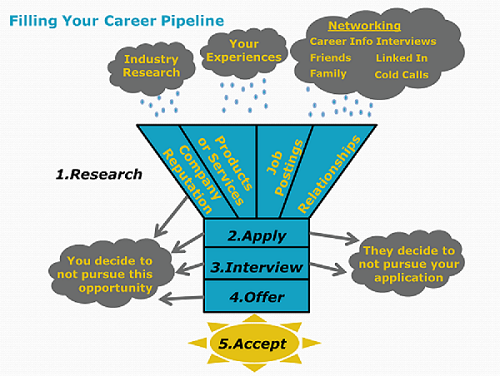 Like any professional service, fees for career coaching can be an issue. The payoff from career coaching is immense. It leads to higher satisfaction, more fulfillment and more pay. If you can afford career coaching, you will find it a worthwhile investment.
Like any professional service, fees for career coaching can be an issue. The payoff from career coaching is immense. It leads to higher satisfaction, more fulfillment and more pay. If you can afford career coaching, you will find it a worthwhile investment.
What if you can’t afford career coaching? If you are a recent college graduate, I recommend using your alma mater’s career center. If you are leaving a company, negotiate for career coaching as part of your outplacement package. You can also check to see what career development services are available from your state or local government.
Whatever you do, don’t settle. Don’t resign yourself to a dead-end job or unemployment. Don’t tolerate a poisonous work situation. Don’t say yes to an unattractive job offer. Pursue your dream job with the dedication of an Olympic hopeful. Fine tune your search skills like a professional golfer on the driving range. And, invest time and money to get the best career coaching you can get.
What to Expect from Executive Coaching
Allen Slade
Promising athletes who want to reach the top almost always have a coach. When they reach the highest level of competition – the Olympics, the NFL, the World Cup, the PGA/LPGA – coaching is even more important.
Coaching is valuable for leaders also. Leadership coaching increases your ability to achieve results, build healthy relationships and stretch into your best self as a leader. Leadership coaching is better than training or mentoring at developing leaders. To get to the top of any field – executive management or professional golf – is hard. To stay on top is even harder. If leadership coaching is good early in your career, then executive coaching is absolutely necessary to stay at the top.
Executive coaching builds on leadership coaching in many ways. Executive coaches help you continue to polish your leadership skills while they help you build skills in strategic thinking and leading from a distance.
Strategic thinking is the seeing the big picture of organizational success. As an executive, you must be look for dynamic systems and complex interactions. You cannot master only functional strategy. You must have a general management perspective that integrates all functions – operations, marketing, finance and people – to create bottom line success. You must grow the business: competitive strategy to maximize your market positions and corporate strategy to manage your mix of businesses. You may have had a business class with business growth strategy models like this:
I have taught strategy (using diagrams like this). I have also managed strategy. Trust me, strategy is more complicated in practice than in the classroom. An executive coach can be your thinking partner as you stretch into new levels of strategy formulation, implementation and evaluation.
Leading from a distance is the ability to lead with or without substantial personal contact. As an executive, you may have mastered interpersonal leadership, but now you must also be influential with people you hardly know. Leading from a distance requires broadcast communication skills like speeches, all-hands email and other mass communication. With hundreds or thousands of employees, you must also become expert at listening at a distance – getting upward feedback from the managers who work for you, from employee surveys and from town hall meetings. Executives may also need to move beyond interpersonal leadership presence to true charisma. A coach can help you jumpstart your broadcast communication, feedback and charisma.
An executive is a competent leader, and more. An executive coach should be a competent leadership coach, and more. An executive coach should have a proven track record as a leadership coach (including accreditation by the International Coach Federation), real-world strategy experience and facility with large group communication and feedback. Executive coaches should have experience as an executive or C-suite consultant. They may have graduate education in strategy or organizational psychology.
Being at the top can be lonely. Executives stand out from the pack in performance, but they also stand out because they have passed by their peers and almost all potential mentors. As the CEO, you truly have no peers in your organization. Your board has to balance helping you succeed with its fiduciary responsibility to evaluate your performance. An executive coach is a safe partner to discuss your strenghts and weaknesses. Your coach can help you turn your failures and shortcomings into learning opportunities without imposing judgement on you.
Chemistry between you and your executive coach is important. I recommend working with a firm that has a stable of proven executive coaches. Then, if you and your coach do not have the right chemistry, there are other coaches who can step in to give you the help you deserve. At Slade & Associates, we have a range of coaches, including our own associates and executive coaches at Healthy Companies International.
As an executive, you should have experts to help you maximize the financial and operational performance of your organization. You should also have an expert to maximize your own performance. If you need an executive coach, get one. If you have an executive coach already, throw yourself into improving your executive performance. If the chemistry with your executive coach is not right, get the executive coach that fits your needs. Do whatever it takes to get the coaching you need to stay at the top of your game.
What to Expect from Leadership Coaching
Allen Slade
Gifts can be a source of joy or a nasty surprise. If your company provides you a leadership coach, how should you react? Heartfelt delight or muted disappointment? Is leadership coaching the perfect gift for you? Or is it the ugly sweater?
Leadership coaching is a powerful gift when it works as designed. Coaching increases your ability to achieve results and build healthy relationships. It helps you stretch into your best self as a leader.
A talented and wise coach (preferably accredited) will help you stretch into your best self. The coaching conversation can be the high point of your week. Your coach’s insightful listening and powerful questions can trigger new insights into your leadership. The best coaches assume that you are the expert on your own situation. Your coach will draw out your expertise through inquiry, curiosity and gentle challenges. The mini-experiments you design together can lead to breakthroughs in your influence and your presence as a leader.
Leadership coaching comes in different flavors:
Coaching for achievement maximizes your performance in your current role. The leader wants to move from good to great. Your leadership coach will help you focus on the behaviors and thinking necessary to supercharge performance. For achievement coaching to have maximum value, you need to have already learned the ropes. That means 6 months or more in your current job.
Coaching in transition helps you adjust to a new role so you can have a fast start. Your coach will help you learn the ropes – making sense of your new role. Rapid sense-making will help you adjust your behavior, thinking and expectations to accelerate maximum performance in your new role. Transition coaching may start before, during, or soon after the leader has moved into a new role. Sometimes, recruiting firms will provide a leadership coach to ensure that the placement has the greatest odds of success.
Coaching in crisis is designed to turn around an unsuccessful situation. The leader’s performance is unacceptable in one or more ways, and the leader and the organization want to improve the situation. Successful crisis coaching requires the leader, HR and the leader’s manager to agree to have mutual candor, commitment to change and the expectation that things can improve.
When can the gift of coaching turn out to be an ugly sweater? One example is coaching in crisis when the organization has already decided to end the leader’s employment. Another example is when the leader’s confidentiality is violated.
Most ICF accredited coaches take steps to avoid these situations. If no turnaround is possible, Slade & Associates does not offer coaching in crisis. (However, if the leader’s employment is at an end, we gladly offer career coaching as part of outplacement packages.) We always require a written agreement of strict confidentiality. Our approach to leadership coaching safeguards our dialogue, maximizes your insight and drives intelligent change for your organization.

Leadership coaching is an incredible benefit. If your organization offers you a leadership coach, accept the gift gladly. Check on the coach’s credentials. Make sure your coach, your organization and you agree on the purpose of the coaching. Demand coaching confidentiality. Then, prepare to be surprised and delighted as you unwrap the insights and wisdom of leadership coaching.
Many Mini-Experiments
Allen Slade
In Teachers, Mentors and Coaches, I made the case for the value of coaching for adults who want to grow as leaders. Teachers impart expertise. Mentors impart experience. Coaches create dialogue and insight for intelligent change. And a big part of what coaches do is to create mini-experiments.
Coaching dialogue is different from normal conversation. At the beginning, a client and I reconnect and check on previous mini-experiments. In the middle, we discuss the issues facing the client. I bring active listening, powerful questions and direct communication to the conversation. I do not bring an agenda. You, the client, set the agenda, because you are the expert in your own situation. If you want to talk about next week’s meeting, the marketing strategy, a difficult customer or the new IT system, I am good with that.
If the first 50 minutes are dialogue and insight, the last ten minutes are action planning. I work with my clients to create mini-experiments at the end of each coaching session. A mini-experiment is an action plan to try something new and different. For an executive, this might be a different approach to growth strategies. For a leader, it might be managing emotions before a speech. For a career coaching client, it could be a simulated interview. Since the client is the expert on the situation, I propose mini-experiments as a SMART request. The mini-experiment is SMART because it is specific, measurable, actionable, realistic and time-bound. It is a request because the client can respond yes, no, offer to negotiate or decide later. We usually negotiate – the client raises valid concerns, and I ask “What would work?” Together, we create something SMART that can drive intelligent change.
Whether in the physics lab or the conference room, an experiment requires a hypothesis and measures. The hypothesis might be “If I do [something different], then my strategies/speech/interview will be better.” To figure out whether the hypothesis holds water, we need measures that produce data. The best data will compare the old way of doing things with the new way. This data needs to be credible and relevant to you the client, so that you are confident of your evaluation of the different way of doing things. We probably don’t need the rigor of a sophisticated experimental design or statistics. What works for you works for me as your coach.
A leadership coaching client was having difficulty with a key executive. Our coaching conversation hinged on how the executive fell short of expectations. However, my client saw the needs of his customers as an opportunity for creative problem solving and servant leadership. We reached a key insight: customer shortcomings were energizing but executive shortcomings were deflating. We designed a mini-experiment: “Think of your boss as your customer for the next week. See how that impacts your attitude toward your boss.” At our next coaching session, I checked on how the mini-experiment went. My client reported it was hard to think of his boss as a customer. But when he did, he had a more positive attitude, resulting in upward problem solving and service to his boss.
This was not a “bet your career” experiment. It happened to work. If it had not worked, we would have discussed why, and either tried the “boss as customer” idea again with a SMARTer action plan or else come up with a new approach. Because of minimal risk, quick turnaround and limited effort, you can do many mini-experiments.
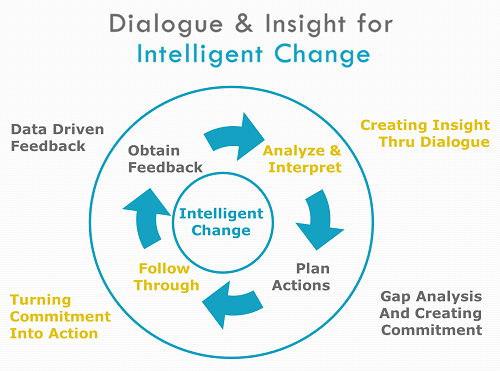 Mini-experiments are planned actions driven by feedback, dialogue and insight. When the mini-experiment is completed, we have another round of feedback, dialogue and insight. And another mini-experiment. The beauty of many mini-experiments is something is bound to make a difference. That’s why we call it intelligent change.
Mini-experiments are planned actions driven by feedback, dialogue and insight. When the mini-experiment is completed, we have another round of feedback, dialogue and insight. And another mini-experiment. The beauty of many mini-experiments is something is bound to make a difference. That’s why we call it intelligent change.
Interview: Managing Emotions and Coaching
Allen Slade with Elaine B. Grieves
This one hour conversation covered how to manage emotions and the positive impact of coaching. The interview appeared on Leader Talk, an internet radio show.
Teachers, Mentors and Coaches
Allen Slade
Who sparks your growth as a leader? Who triggers dramatic turnarounds in your career?
As kids, growth was our job, but someone else set the agenda. Adults, including our parents and teachers, helped us climb the ladder to maturity. As we climbed, we took more responsibility for our own learning. The college professor did not manage our days like the kindergarten teacher. After college, we became even more specialized in skills, more complex in thinking and more diverse in motivation.
So, who has the biggest role in your learning today? A teacher? A mentor? A coach?
Teachers impart knowledge based on their expertise. The best teachers are subject matter experts with strong platform skills. They know the material and they know how to deliver it. Yet, corporate training classes suffer from a lack of transfer of training back to the work situation. Traditional teaching does not impact adults like it impacts 5-year olds. Adults need individualized, experienced-based growth.
Mentors impart wisdom based on their experience. Mentoring can be a powerful experience, sharing personalized knowledge and advice customized to the needs of the mentee or protégé. Yet, mentoring tends to be hit or miss. Most formal mentoring relationships do not make it past the second meeting.
At the extreme, teaching and mentoring requires adult learners to suspend their disbelief in their own expertise and experience. Teaching and mentoring are built on a shaky assumption:
You do not know what you need or how to get it. You need an expert teacher or an experienced mentor to guide your learning.
Our adult mindset resists returning to this child-like belief. “He got schooled” is a taunt rather than an effective training strategy. “Listen to your parents” grates on teenagers, so it is not surprising that mentoring often misfires for adults.
Coaches are different. A coach believes you are the expert in your own situation. Instead of giving you the answer, a coach is more likely to ask questions. Instead of setting goals for you, a coach will help you define your own goals. Instead of holding you accountable, a coach helps you hold yourself accountable.
Coaches give up control to gain influence. As a professor, I required my students to show up at the appointed time and place, ready to discuss the assigned readings. But once the final grades were in, my control ended and my influence largely disappeared. As a coach, my influence is soft but lasting. As a coach, I don’t tell people what to do, how to do it or when it is due. I just ask questions and share distinctions. I request behavioral agreements, but I encourage my client to say no to my requests. I do not enforce the agreements. I merely ask about the impact of not following through. Yet, the impact of coaching can be life-long, resulting in new thinking patterns, more effective habits and changed values, attitudes, beliefs and expectations.
Bottom line: Training and mentoring have limited impact on experienced professionals, leaders and executives. Coaching is more likely to maximize your leadership influence or trigger a career turnaround.
There are situations that call for training or mentoring. Training works well for transfer of knowledge, like learning a new online application. Mentoring is great for new hires. However, for most adults in most situations, coaching is more powerful than either teaching or mentoring.
The difficulty with coaching is cost. In comparison to one-on-one sessions with a certified coach, classroom training is cheap. Mentoring is free.
Cost is important, but not the only consideration, especially when we seek life changing assistance. We don’t typically look for the cheapest medical care. We turn to our company for health insurance. We don’t depend on free legal advice. We budget to pay for an attorney.
If you seek leadership coaching, take advantage of what your company offers. You may have an internal coaching program or a personal development budget.
If you seek career coaching, budget for it. Your return, in increased salary and life satisfaction, will be worth the investment.
Don’t wait for someone else to decide what you need. If you think you would benefit from coaching, you are right. You are right, not because you agree with some expert on coaching. You are right because you are the expert on your own growth.








